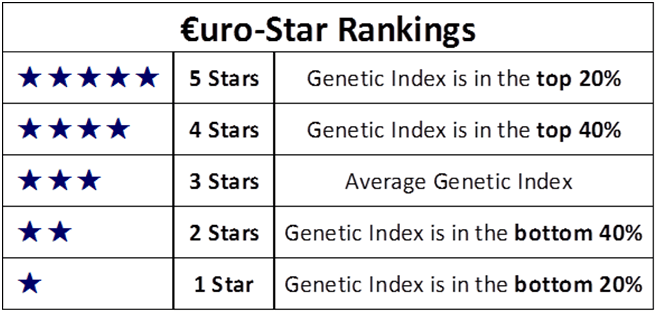The Active Beef Bull Lists show the highest ranked Beef AI Sires on the ‘Replacement’ & ‘Terminal’ indexes that have semen widely available, based on the March 2021 genetic evaluations computed by ICBF.
Pat Donnellan, ICBF explains
- Beef Active Bull List – Replacement
- Beef Active Bull List – Terminal
- Beef Active Bull List – Dairy Beef
The criteria for making the list are as follows:
- Bull is Genotyped
- Reliability % for ‘Replacement’ or ‘Terminal’ index’ of at least 50%
- Reliability of ‘Calving Difficulty’ of at least 50% (based on 17% heifer rel % and 83% cow rel%).
- Bull must also have calves in his calving survey evaluation.
Gene Ireland
A ‘Yes’ in this column indicates that the bull was progeny tested through the Gene Ireland maternal progeny test programme. This is a programme where ICBF contacts beef farmers and coordinates the distribution of the semen and collection of data on those bulls daughters. This programme results in bull’s receiving extremely accurate evaluations without excessive amounts of semen having to be dispatched while they are still genetically unproven.
Understand the terminology
- Bull Details: Rank, AI Code, Name, Breed, Gene Irl.
- Replacement or Terminal Index: This is the overall single figure profit index that each bull has. A Bull with a Replacement Index of €200 is expected to sire daughters that are €200 more profitable than the average Irish suckler cow. Likewise, for the ‘Terminal Index’, it is an indication of how profitable a bull’s progeny will be when slaughtered.
- Reliability %: This figure is an indication as to how confident ICBF can be about the genetic evaluations for a particular bull. Progeny of a bull having data recorded on them (calving survey, weights etc) alongside lots of other animals, across large numbers of herds is what increases a bull’s reliability % figure. The ‘reliability %’ figures for AI Sires is generally higher than that of Stockbulls due to the large number of calves across many herds that they would sire.
- Stars Across: This shows the percentile ranking of the bulls index when compared across breed (5 stars: top 20%, 1 star: bottom 20%).
- Calving Difficulty Details: This is the first Active Bull List with the new Calving indices.
Beef Heifer CD% & Beef Cow CD%: This shows the calving difficulty % figure expected for the bull when used on beef heifers and beef cows. Reliability % figures are also shown.
Beef Calv Recs: This shows the number of actual calves sired by each bull that were born in Ireland out of dairy animals and with calving survey records included in evaluations.
- Gest (Days) & Gest (Rel %): This shows the expected affect on gestation length that the bull will have. The smaller and more negative the breeding value figure here the better.
- Daughter Milk: Daughter Milk is the expected level of milk that daughters of a bull will have. It is expressed in terms of the kg’s weight gain from the progeny of those daughters (high values desired).
- Daughter Calving Interval: Daughter Calving Interval is a key measurement of fertility in a bull’s daughters. It is measured in terms of ‘Calving Interval’ – (negative & low values desired).
- Carcass Weight & Carcass Conformation: This shows the extra kgs of carcass and increased conformation that is expected from progeny of each bull.
- Semen Details; Availability, Price, and supplier details of each bull are included.
€uro-Stars
The actual €uro-Stars just make the €uro Index values visually
easy to understand. The €uro-Stars show where the animal’s
genetic index ranks (top 20%, bottom 20% etc).

Dairy Beef Index
The Dairy Beef Index (DBI)is a tool to produce quality Beef cattle from the dairy herd that have both desirable calving attributes for the dairy herd (i.e. easy calving and short gestation) and valuable carcass merit attributes for the finisher.
It does this ranking beef cattle for use in the dairy herd based on their genetic merit for several traits that are important to dairy-beef production systems (i.e. calving and beef traits).
So the Dairy Beef Index selects for:
- Easy calving, short gestation and less calf mortality.
- Heavier carcasses of greater conformation and lower fat scores.
- Cattle that are polled and docile with lower feed intake.
Using a bull only for his ‘easy calving’ or ‘short gestation’ can result in lighter carcasses. However incorporating several traits into selection decisions using an overall index (Dairy Beef Index) can produce more balanced cattle with more favourable economic returns.
- Bulls with greater than or equal to 100 dairy calving records are included on the DBI list.
- Risk of Dairy Heifer CDiff: This is either ‘Low’, ‘Moderate’ or ‘High’ and indicates the level of risk associated with calving difficulty when used on dairy heifers. It combines the PTA and the reliability.
- Out of Spec: A very interesting feature on the ‘DBI’ list s a column showing the percentage of a bull’s progeny that will be out of spec when slaughtered. This is probably the biggest issue before the DBI index was created as the problem with just selecting very easy calving bulls was that their progeny were not able to hit the target weights and grades in the factories afterwards.
